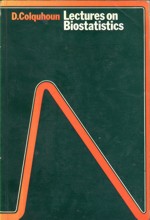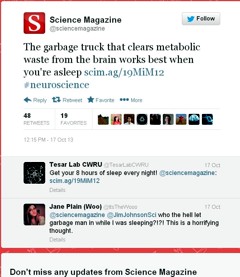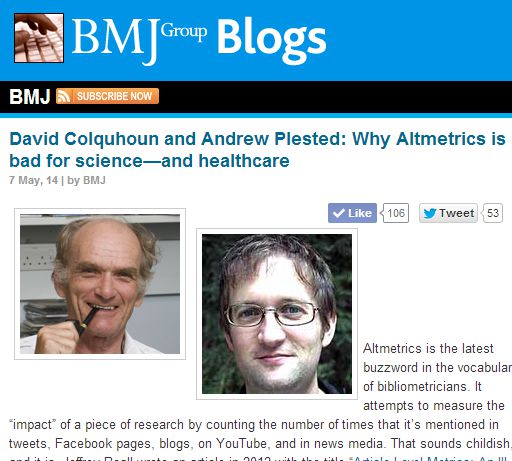peer review
This discussion seemed to be of sufficient general interest that we submitted is as a feature to eLife, because this journal is one of the best steps into the future of scientific publishing. Sadly the features editor thought that " too much of the article is taken up with detailed criticisms of research papers from NEJM and Science that appeared in the altmetrics top 100 for 2013; while many of these criticisms seems valid, the Features section of eLife is not the venue where they should be published". That’s pretty typical of what most journals would say. It is that sort of attitude that stifles criticism, and that is part of the problem. We should be encouraging post-publication peer review, not suppressing it. Luckily, thanks to the web, we are now much less constrained by journal editors than we used to be.
Here it is.
Scientists don’t count: why you should ignore altmetrics and other bibliometric nightmares
David Colquhoun1 and Andrew Plested2
1 University College London, Gower Street, London WC1E 6BT
2 Leibniz-Institut für Molekulare Pharmakologie (FMP) & Cluster of Excellence NeuroCure, Charité Universitätsmedizin,Timoféeff-Ressowsky-Haus, Robert-Rössle-Str. 10, 13125 Berlin Germany.
Jeffrey Beall is librarian at Auraria Library, University of Colorado Denver. Although not a scientist himself, he, more than anyone, has done science a great service by listing the predatory journals that have sprung up in the wake of pressure for open access. In August 2012 he published “Article-Level Metrics: An Ill-Conceived and Meretricious Idea. At first reading that criticism seemed a bit strong. On mature consideration, it understates the potential that bibliometrics, altmetrics especially, have to undermine both science and scientists.
Altmetrics is the latest buzzword in the vocabulary of bibliometricians. It attempts to measure the “impact” of a piece of research by counting the number of times that it’s mentioned in tweets, Facebook pages, blogs, YouTube and news media. That sounds childish, and it is. Twitter is an excellent tool for journalism. It’s good for debunking bad science, and for spreading links, but too brief for serious discussions. It’s rarely useful for real science.
Surveys suggest that the great majority of scientists do not use twitter (7 — 13%). Scientific works get tweeted about mostly because they have titles that contain buzzwords, not because they represent great science.
What and who is Altmetrics for?
The aims of altmetrics are ambiguous to the point of dishonesty; they depend on whether the salesperson is talking to a scientist or to a potential buyer of their wares.
At a meeting in London , an employee of altmetric.com said “we measure online attention surrounding journal articles” “we are not measuring quality …” “this whole altmetrics data service was born as a service for publishers”, “it doesn’t matter if you got 1000 tweets . . .all you need is one blog post that indicates that someone got some value from that paper”.
These ideas sound fairly harmless, but in stark contrast, Jason Priem (an author of the altmetrics manifesto) said one advantage of altmetrics is that it’s fast “Speed: months or weeks, not years: faster evaluations for tenure/hiring”. Although conceivably useful for disseminating preliminary results, such speed isn’t important for serious science (the kind that ought to be considered for tenure) which operates on the timescale of years. Priem also says “researchers must ask if altmetrics really reflect impact” . Even he doesn’t know, yet altmetrics services are being sold to universities, before any evaluation of their usefulness has been done, and universities are buying them. The idea that altmetrics scores could be used for hiring is nothing short of terrifying.
The problem with bibliometrics
The mistake made by all bibliometricians is that they fail to consider the content of papers, because they have no desire to understand research. Bibliometrics are for people who aren’t prepared to take the time (or lack the mental capacity) to evaluate research by reading about it, or in the case of software or databases, by using them. The use of surrogate outcomes in clinical trials is rightly condemned. Bibliometrics are all about surrogate outcomes.
If instead we consider the work described in particular papers that most people agree to be important (or that everyone agrees to be bad), it’s immediately obvious that no publication metrics can measure quality. There are some examples in How to get good science (Colquhoun, 2007). It is shown there that at least one Nobel prize winner failed dismally to fulfil arbitrary biblometric productivity criteria of the sort imposed in some universities (another example is in Is Queen Mary University of London trying to commit scientific suicide?).
Schekman (2013) has said that science
“is disfigured by inappropriate incentives. The prevailing structures of personal reputation and career advancement mean the biggest rewards often follow the flashiest work, not the best.”
Bibliometrics reinforce those inappropriate incentives. A few examples will show that altmetrics are one of the silliest metrics so far proposed.
The altmetrics top 100 for 2103
The superficiality of altmetrics is demonstrated beautifully by the list of the 100 papers with the highest altmetric scores in 2013 For a start, 58 of the 100 were behind paywalls, and so unlikely to have been read except (perhaps) by academics.
The second most popular paper (with the enormous altmetric score of 2230) was published in the New England Journal of Medicine. The title was Primary Prevention of Cardiovascular Disease with a Mediterranean Diet. It was promoted (inaccurately) by the journal with the following tweet:

Many of the 2092 tweets related to this article simply gave the title, but inevitably the theme appealed to diet faddists, with plenty of tweets like the following:


The interpretations of the paper promoted by these tweets were mostly desperately inaccurate. Diet studies are anyway notoriously unreliable. As John Ioannidis has said
"Almost every single nutrient imaginable has peer reviewed publications associating it with almost any outcome."
This sad situation comes about partly because most of the data comes from non-randomised cohort studies that tell you nothing about causality, and also because the effects of diet on health seem to be quite small.
The study in question was a randomized controlled trial, so it should be free of the problems of cohort studies. But very few tweeters showed any sign of having read the paper. When you read it you find that the story isn’t so simple. Many of the problems are pointed out in the online comments that follow the paper. Post-publication peer review really can work, but you have to read the paper. The conclusions are pretty conclusively demolished in the comments, such as:
“I’m surrounded by olive groves here in Australia and love the hand-pressed EVOO [extra virgin olive oil], which I can buy at a local produce market BUT this study shows that I won’t live a minute longer, and it won’t prevent a heart attack.”
We found no tweets that mentioned the finding from the paper that the diets had no detectable effect on myocardial infarction, death from cardiovascular causes, or death from any cause. The only difference was in the number of people who had strokes, and that showed a very unimpressive P = 0.04.
Neither did we see any tweets that mentioned the truly impressive list of conflicts of interest of the authors, which ran to an astonishing 419 words.
“Dr. Estruch reports serving on the board of and receiving lecture fees from the Research Foundation on Wine and Nutrition (FIVIN); serving on the boards of the Beer and Health Foundation and the European Foundation for Alcohol Research (ERAB); receiving lecture fees from Cerveceros de España and Sanofi-Aventis; and receiving grant support through his institution from Novartis. Dr. Ros reports serving on the board of and receiving travel support, as well as grant support through his institution, from the California Walnut Commission; serving on the board of the Flora Foundation (Unilever). . . “
And so on, for another 328 words.
The interesting question is how such a paper came to be published in the hugely prestigious New England Journal of Medicine. That it happened is yet another reason to distrust impact factors. It seems to be another sign that glamour journals are more concerned with trendiness than quality.
One sign of that is the fact that the journal’s own tweet misrepresented the work. The irresponsible spin in this initial tweet from the journal started the ball rolling, and after this point, the content of the paper itself became irrelevant. The altmetrics score is utterly disconnected from the science reported in the paper: it more closely reflects wishful thinking and confirmation bias.
The fourth paper in the altmetrics top 100 is an equally instructive example.
|
This work was also published in a glamour journal, Science. The paper claimed that a function of sleep was to “clear metabolic waste from the brain”. It was initially promoted (inaccurately) on Twitter by the publisher of Science. After that, the paper was retweeted many times, presumably because everybody sleeps, and perhaps because the title hinted at the trendy, but fraudulent, idea of “detox”. Many tweets were variants of “The garbage truck that clears metabolic waste from the brain works best when you’re asleep”. |
But this paper was hidden behind Science’s paywall. It’s bordering on irresponsible for journals to promote on social media papers that can’t be read freely. It’s unlikely that anyone outside academia had read it, and therefore few of the tweeters had any idea of the actual content, or the way the research was done. Nevertheless it got “1,479 tweets from 1,355 accounts with an upper bound of 1,110,974 combined followers”. It had the huge Altmetrics score of 1848, the highest altmetric score in October 2013.
Within a couple of days, the story fell out of the news cycle. It was not a bad paper, but neither was it a huge breakthrough. It didn’t show that naturally-produced metabolites were cleared more quickly, just that injected substances were cleared faster when the mice were asleep or anaesthetised. This finding might or might not have physiological consequences for mice.
Worse, the paper also claimed that “Administration of adrenergic antagonists induced an increase in CSF tracer influx, resulting in rates of CSF tracer influx that were more comparable with influx observed during sleep or anesthesia than in the awake state”. Simply put, giving the sleeping mice a drug could reduce the clearance to wakeful levels. But nobody seemed to notice the absurd concentrations of antagonists that were used in these experiments: “adrenergic receptor antagonists (prazosin, atipamezole, and propranolol, each 2 mM) were then slowly infused via the cisterna magna cannula for 15 min”. Use of such high concentrations is asking for non-specific effects. The binding constant (concentration to occupy half the receptors) for prazosin is less than 1 nM, so infusing 2 mM is working at a million times greater than the concentration that should be effective. That’s asking for non-specific effects. Most drugs at this sort of concentration have local anaesthetic effects, so perhaps it isn’t surprising that the effects resembled those of ketamine.
The altmetrics editor hadn’t noticed the problems and none of them featured in the online buzz. That’s partly because to find it out you had to read the paper (the antagonist concentrations were hidden in the legend of Figure 4), and partly because you needed to know the binding constant for prazosin to see this warning sign.
The lesson, as usual, is that if you want to know about the quality of a paper, you have to read it. Commenting on a paper without knowing anything of its content is liable to make you look like an jackass.
A tale of two papers
Another approach that looks at individual papers is to compare some of one’s own papers. Sadly, UCL shows altmetric scores on each of your own papers. Mostly they are question marks, because nothing published before 2011 is scored. But two recent papers make an interesting contrast. One is from DC’s side interest in quackery, one was real science. The former has an altmetric score of 169, the latter has an altmetric score of 2.
|
The first paper was “Acupuncture is a theatrical placebo”, which was published as an invited editorial in Anesthesia and Analgesia [download pdf]. The paper was scientifically trivial. It took perhaps a week to write. Nevertheless, it got promoted it on twitter, because anything to do with alternative medicine is interesting to the public. It got quite a lot of retweets. And the resulting altmetric score of 169 put it in the top 1% of all articles altmetric have tracked, and the second highest ever for Anesthesia and Analgesia. As well as the journal’s own website, the article was also posted on the DCScience.net blog (May 30, 2013) where it soon became the most viewed page ever (24,468 views as of 23 November 2013), something that altmetrics does not seem to take into account. |

|
Compare this with the fate of some real, but rather technical, science.
|
My [DC] best scientific papers are too old (i.e. before 2011) to have an altmetrics score, but my best score for any scientific paper is 2. This score was for Colquhoun & Lape (2012) “Allosteric coupling in ligand-gated ion channels”. It was a commentary with some original material. The altmetric score was based on two tweets and 15 readers on Mendeley. The two tweets consisted of one from me (“Real science; The meaning of allosteric conformation changes http://t.co/zZeNtLdU ”). The only other tweet as abusive one from a cyberstalker who was upset at having been refused a job years ago. Incredibly, this modest achievement got it rated “Good compared to other articles of the same age (71st percentile)”. |
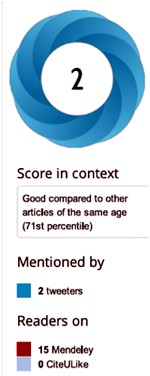
|
Conclusions about bibliometrics
Bibliometricians spend much time correlating one surrogate outcome with another, from which they learn little. What they don’t do is take the time to examine individual papers. Doing that makes it obvious that most metrics, and especially altmetrics, are indeed an ill-conceived and meretricious idea. Universities should know better than to subscribe to them.
Although altmetrics may be the silliest bibliometric idea yet, much this criticism applies equally to all such metrics. Even the most plausible metric, counting citations, is easily shown to be nonsense by simply considering individual papers. All you have to do is choose some papers that are universally agreed to be good, and some that are bad, and see how metrics fail to distinguish between them. This is something that bibliometricians fail to do (perhaps because they don’t know enough science to tell which is which). Some examples are given by Colquhoun (2007) (more complete version at dcscience.net).
Eugene Garfield, who started the metrics mania with the journal impact factor (JIF), was clear that it was not suitable as a measure of the worth of individuals. He has been ignored and the JIF has come to dominate the lives of researchers, despite decades of evidence of the harm it does (e.g.Seglen (1997) and Colquhoun (2003) ) In the wake of JIF, young, bright people have been encouraged to develop yet more spurious metrics (of which ‘altmetrics’ is the latest). It doesn’t matter much whether these metrics are based on nonsense (like counting hashtags) or rely on counting links or comments on a journal website. They won’t (and can’t) indicate what is important about a piece of research- its quality.
People say – I can’t be a polymath. Well, then don’t try to be. You don’t have to have an opinion on things that you don’t understand. The number of people who really do have to have an overview, of the kind that altmetrics might purport to give, those who have to make funding decisions about work that they are not intimately familiar with, is quite small. Chances are, you are not one of them. We review plenty of papers and grants. But it’s not credible to accept assignments outside of your field, and then rely on metrics to assess the quality of the scientific work or the proposal.
It’s perfectly reasonable to give credit for all forms of research outputs, not only papers. That doesn’t need metrics. It’s nonsense to suggest that altmetrics are needed because research outputs are not already valued in grant and job applications. If you write a grant for almost any agency, you can put your CV. If you have a non-publication based output, you can always include it. Metrics are not needed. If you write software, get the numbers of downloads. Software normally garners citations anyway if it’s of any use to the greater community.
When AP recently wrote a criticism of Heather Piwowar’s altmetrics note in Nature, one correspondent wrote: "I haven’t read the piece [by HP] but I’m sure you are mischaracterising it". This attitude summarizes the too-long-didn’t-read (TLDR) culture that is increasingly becoming accepted amongst scientists, and which the comparisons above show is a central component of altmetrics.
Altmetrics are numbers generated by people who don’t understand research, for people who don’t understand research. People who read papers and understand research just don’t need them and should shun them.
But all bibliometrics give cause for concern, beyond their lack of utility. They do active harm to science. They encourage “gaming” (a euphemism for cheating). They encourage short-term eye-catching research of questionable quality and reproducibility. They encourage guest authorships: that is, they encourage people to claim credit for work which isn’t theirs. At worst, they encourage fraud.
No doubt metrics have played some part in the crisis of irreproducibility that has engulfed some fields, particularly experimental psychology, genomics and cancer research. Underpowered studies with a high false-positive rate may get you promoted, but tend to mislead both other scientists and the public (who in general pay for the work). The waste of public money that must result from following up badly done work that can’t be reproduced but that was published for the sake of “getting something out” has not been quantified, but must be considered to the detriment of bibliometrics, and sadly overcomes any advantages from rapid dissemination. Yet universities continue to pay publishers to provide these measures, which do nothing but harm. And the general public has noticed.
It’s now eight years since the New York Times brought to the attention of the public that some scientists engage in puffery, cheating and even fraud.
Overblown press releases written by journals, with connivance of university PR wonks and with the connivance of the authors, sometimes go viral on social media (and so score well on altmetrics). Yet another example, from Journal of the American Medical Association involved an overblown press release from the Journal about a trial that allegedly showed a benefit of high doses of Vitamin E for Alzheimer’s disease.
This sort of puffery harms patients and harms science itself.
We can’t go on like this.
What should be done?
Post publication peer review is now happening, in comments on published papers and through sites like PubPeer, where it is already clear that anonymous peer review can work really well. New journals like eLife have open comments after each paper, though authors do not seem to have yet got into the habit of using them constructively. They will.
It’s very obvious that too many papers are being published, and that anything, however bad, can be published in a journal that claims to be peer reviewed . To a large extent this is just another example of the harm done to science by metrics –the publish or perish culture.
Attempts to regulate science by setting “productivity targets” is doomed to do as much harm to science as it has in the National Health Service in the UK. This has been known to economists for a long time, under the name of Goodhart’s law.
Here are some ideas about how we could restore the confidence of both scientists and of the public in the integrity of published work.
- Nature, Science, and other vanity journals should become news magazines only. Their glamour value distorts science and encourages dishonesty.
- Print journals are overpriced and outdated. They are no longer needed. Publishing on the web is cheap, and it allows open access and post-publication peer review. Every paper should be followed by an open comments section, with anonymity allowed. The old publishers should go the same way as the handloom weavers. Their time has passed.
- Web publication allows proper explanation of methods, without the page, word and figure limits that distort papers in vanity journals. This would also make it very easy to publish negative work, thus reducing publication bias, a major problem (not least for clinical trials)
- Publish or perish has proved counterproductive. It seems just as likely that better science will result without any performance management at all. All that’s needed is peer review of grant applications.
- Providing more small grants rather than fewer big ones should help to reduce the pressure to publish which distorts the literature. The ‘celebrity scientist’, running a huge group funded by giant grants has not worked well. It’s led to poor mentoring, and, at worst, fraud. Of course huge groups sometimes produce good work, but too often at the price of exploitation of junior scientists
- There is a good case for limiting the number of original papers that an individual can publish per year, and/or total funding. Fewer but more complete and considered papers would benefit everyone, and counteract the flood of literature that has led to superficiality.
- Everyone should read, learn and inwardly digest Peter Lawrence’s The Mismeasurement of Science.
A focus on speed and brevity (cited as major advantages of altmetrics) will help no-one in the end. And a focus on creating and curating new metrics will simply skew science in yet another unsatisfactory way, and rob scientists of the time they need to do their real job: generate new knowledge.
It has been said
“Creation is sloppy; discovery is messy; exploration is dangerous. What’s a manager to do?
The answer in general is to encourage curiosity and accept failure. Lots of failure.”
And, one might add, forget metrics. All of them.
Follow-up
17 Jan 2014
This piece was noticed by the Economist. Their ‘Writing worth reading‘ section said
"Why you should ignore altmetrics (David Colquhoun) Altmetrics attempt to rank scientific papers by their popularity on social media. David Colquohoun [sic] argues that they are “for people who aren’t prepared to take the time (or lack the mental capacity) to evaluate research by reading about it.”"
20 January 2014.
Jason Priem, of ImpactStory, has responded to this article on his own blog. In Altmetrics: A Bibliographic Nightmare? he seems to back off a lot from his earlier claim (cited above) that altmetrics are useful for making decisions about hiring or tenure. Our response is on his blog.
20 January 2014.
Jason Priem, of ImpactStory, has responded to this article on his own blog, In Altmetrics: A bibliographic Nightmare? he seems to back off a lot from his earlier claim (cited above) that altmetrics are useful for making decisions about hiring or tenure. Our response is on his blog.
23 January 2014
The Scholarly Kitchen blog carried another paean to metrics, A vigorous discussion followed. The general line that I’ve followed in this discussion, and those mentioned below, is that bibliometricians won’t qualify as scientists until they test their methods, i.e. show that they predict something useful. In order to do that, they’ll have to consider individual papers (as we do above). At present, articles by bibliometricians consist largely of hubris, with little emphasis on the potential to cause corruption. They remind me of articles by homeopaths: their aim is to sell a product (sometimes for cash, but mainly to promote the authors’ usefulness).
It’s noticeable that all of the pro-metrics articles cited here have been written by bibliometricians. None have been written by scientists.
28 January 2014.
Dalmeet Singh Chawla,a bibliometrician from Imperial College London, wrote a blog on the topic. (Imperial, at least in its Medicine department, is notorious for abuse of metrics.)
29 January 2014 Arran Frood wrote a sensible article about the metrics row in Euroscientist.
2 February 2014 Paul Groth (a co-author of the Altmetrics Manifesto) posted more hubristic stuff about altmetrics on Slideshare. A vigorous discussion followed.
5 May 2014. Another vigorous discussion on ImpactStory blog, this time with Stacy Konkiel. She’s another non-scientist trying to tell scientists what to do. The evidence that she produced for the usefulness of altmetrics seemed pathetic to me.
7 May 2014 A much-shortened version of this post appeared in the British Medical Journal (BMJ blogs)
Open access is in the news again.
Index on Censorship held a debate on open data on December 6th.
|
The video of of the meeting is now on YouTube. A couple of dramatic moments in the video: At 48 min O’Neill & Monbiot face off about "competent persons" (and at 58 min Walport makes fun of my contention that it’s better to have more small grants rather than few big ones, on the grounds that it’s impossible to select the stars). |
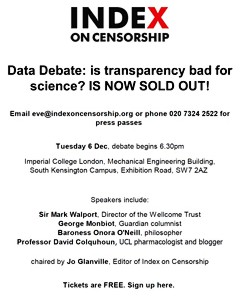
|
The meeting has been written up on the Bishop Hill Blog, with some very fine cartoon minutes.
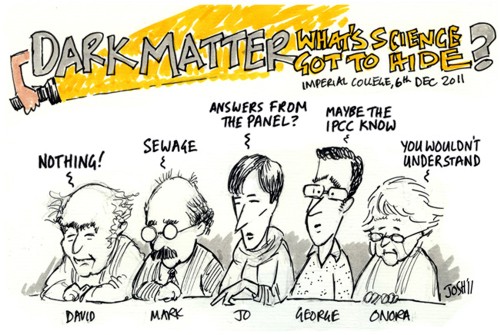 (I love the Josh cartoons -pity he seems to be a climate denier, spoken of approvingly by the unspeakable James Delingpole.)
(I love the Josh cartoons -pity he seems to be a climate denier, spoken of approvingly by the unspeakable James Delingpole.)
It was gratifying that my remarks seemed to be better received by the scientists in the audience than they were by some other panel members. The Bishop Hill blog comments "As David Colquhoun, the only real scientist there and brilliant throughout, said “Give them everything!” " Here’s a subsection of the brilliant cartoon minutes
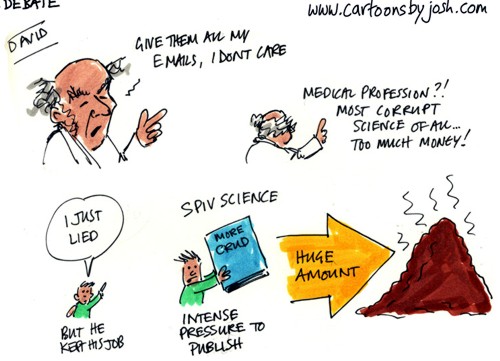
The bit about "I just lied -but he kept his job" referred to the notorious case of Richard Eastell and the University of Sheffield.
We all agreed that papers should be open for anyone to read, free. Monbiot and I both thought that raw data should be available on request, though O’Neill and Walport had a few reservations about that.
A great deal of time and money would be saved if data were provided on request. It shouldn’t need a Freedom of Information Act (FOIA) request, and the time and energy spent on refusing FOIA requests is silly. It simply gives the impression that there is something to hide (Climate scientists must be ruthlessly honest about data). The University of Central Lancashire spent £80,000 of taxpayers’ money trying (unsuccessfully) to appeal against the judgment of the Information Commissioner that they must release course material to me. It’s hard to think of a worse way to spend money.
A few days ago, the Department for Business, Innovation and Skills (BIS) published a report which says (para 6.6)
“The Government . . . is committed to ensuring that publicly-funded research should be accessible
free of charge.”
That’s good, but how it can be achieved is less obvious. Scientific publishing is, at the moment, an unholy mess. It’s a playground for profiteers. It runs on the unpaid labour of academics, who work to generate large profits for publishers. That’s often been said before, recently by both George Monbiot (Academic publishers make Murdoch look like a socialist) and by me (Publish-or-perish: Peer review and the corruption of science). Here are a few details.
Extortionate cost of publishing
Mark Walport has told me that
The Wellcome Trust is currently spending around £3m pa on OA publishing costs and, looking at the Wellcome papers that find their way to UKPMC, we see that around 50% of this content is routed via the “hybrid option”; 40% via the “pure” OA journals (e.g. PLoS, BMC etc), and the remaining 10% through researchers self-archiving their author manuscripts.
I’ve found some interesting numbers, with help from librarians, and through access to The Journal Usage Statistics Portal (JUSP).
Elsevier
UCL pays Elsevier the astonishing sum of €1.25 million, for access to its journals. And that’s just one university. That price doesn’t include any print editions at all, just web access and there is no open access. You have to have a UCL password to see the results. Elsevier has, of course, been criticised before, and not just for its prices.
Elsevier publish around 2700 scientific journals. UCL has bought a package of around 2100 journals. There is no possibility to pick the journals that you want. Some of the journals are used heavily ("use" means access of full text on the web). In 2010, the most heavily used journal was The Lancet, followed by four Cell Press journals
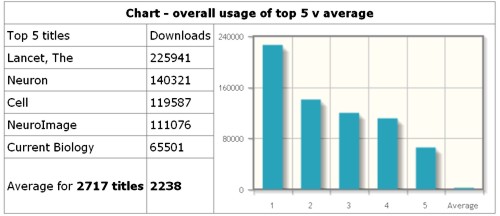
But notice the last bin. Most of the journals are hardly used at all. Among all Elsevier journals, 251 were not accessed even once in 2010. Among the 2068 journals bought by UCL, 56 were never accessed in 2010 and the most frequent number of accesses per year is between 1 and 10 (the second bin in the histogram, below). 60 percent of journals have 300 or fewer usages in 2010, Above 300, the histogram tails on up to 51878 accesses for The Lancet. The remaining 40 percent of journals are represented by the last bin (in red). The distribution is exceedingly skewed. The median is 187, i.e. half of the journals had fewer than 187 usages in 2010), but the mean number of usages (which is misleading for such a skewed distribution, was 662 usages).
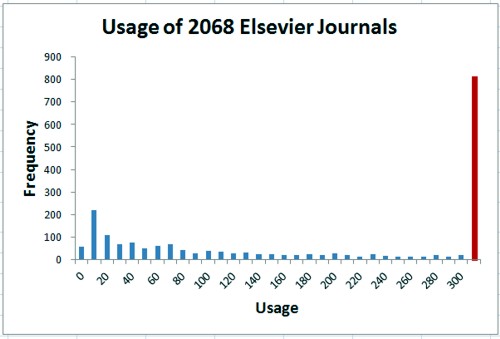
Nature Publishing Group
UCL bought 65 journals from NPG in 2010. They get more use than Elsevier, though surprisingly three of them were never accessed in 2010, and 17 had fewer than 1000 accesses in that year. The median usage was 2412, better than most. The leader, needless to say, was Nature itself, with 153,321.
Oxford University Press
The situation is even more extreme for 248 OUP journals, perhaps because many of the journals are arts or law rather than science.
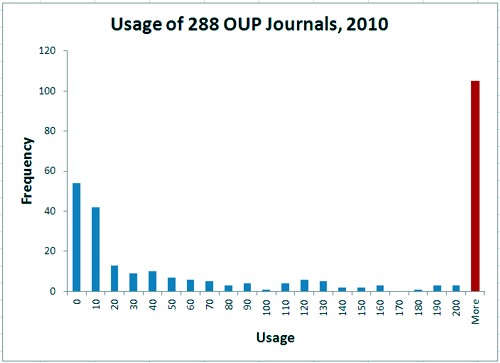
The most frequent (modal) usage of was zero (54 journals), followed by 1 to 10 accesses (42 journals) 64 percent of journals had fewer than 200 usages, and the 36 percent with over 200 are pooled in the last (red) bin. The histogram extends right up to 16060 accesses for Brain. The median number of usages in 2010 was 66.
So far I haven’t been able to discover the costs of the contracts with OUP or Nature Publishing group. It seems that the university has agreed to confidentiality clauses. This itself is a shocking lack of transparency. If I can find the numbers I shall -watch this space.
Almost all of these journals are not open access. The academics do the experiments, most often paid for by the taxpayer. They write the paper (and now it has to be in a form that is almost ready for publication without further work), they send it to the journal, where it is sent for peer review, which is also unpaid. The journal sells the product back to the universities for a high price, where the results of the work are hidden from the people who paid for it.
It’s even worse than that, because often the people who did the work and wrote the paper, have to pay "page charges". These vary, but can be quite high. If you send a paper to the Journal of Neuroscience, it will probably cost you about $1000. Other journals, like the excellent Journal of Physiology, don’t charge you to submit a paper (unless you want a colour figure in the print edition, £200), but the paper is hidden from the public for 12 months unless you pay $3000.
The major medical charity, the Wellcome Trust, requires that the work it funds should be available to the public within 6 months of publication. That’s nothing like good enough to allow the public to judge the claims of a paper which hits the newspapers the day that it’s published. Nevertheless it can cost the authors a lot. Elsevier journals charge $3000 except for their most-used journals. The Lancet charges £400 per page and Cell Press journals charge $5000 for this unsatisfactory form of open access.
Open access journals
The outcry about hidden results has resulted in a new generation of truly open access journals that are open to everyone from day one. But if you want to publish in them you have to pay quite a lot.
Furthermore, although all these journals are free to read, most of them do not allow free use of the material they publish. Most are operating under all-rights-reserved copyrights. In 2009 under 10 percent of open access journals had true Creative Commons licence.
Nature Publishing Group has a true open access journal, Nature Communications, but it costs the author $5000 to publish there. The Public Library of Science journals are truly open access but the author is charged $2900 for PLoS Medicine though PLoS One costs the author only $1350
A 2011 report considered the transition to open access publishing but it doesn’t even consider radical solutions, and makes unreasonably low estimates of the costs of open access publishing.
Scam journals have flourished under the open access flag
Open access publishing has, so far, almost always involved paying a hefty fee. That has brought the rats out of the woodwork and one gets bombarded daily with offers to publish in yet another open access journal. Many of these are simply scams. You pay, we put it on the web and we won’t fuss about quality. Luckily there is now a guide to these crooks: Jeffrey Beall’s List of Predatory, Open-Access Publishers.
One that I hear from regularly is Bentham Open Journals
(a name that is particularly inappropriate for anyone at UCL). Jeffery Beall comments
"Among the first, large-scale gold OA publishers, Bentham Open continues to expand its fleet of journals, now numbering over 230. Bentham essentially operates as a scholarly vanity press."
They undercut real journals. A research article in The Open Neuroscience Journal will cost you a mere $800. Although these journals claim to be peer-reviewed, their standards are suspect. In 2009, a nonsensical computer-generated spoof paper was accepted by a Bentham Journal (for $800),
What can be done about publication, and what can be done about grants?
Both grants and publications are peer-reviewed, but the problems need to be discussed separately.
Peer review of papers by journals
One option is clearly to follow the example of the best open access journals, such as PLoS. The cost of $3000 to 5000 per paper would have to be paid by the research funder, often the taxpayer. It would be money subtracted from the research budget, but it would retain the present peer review system and should cost no more if the money that were saved on extortionate journal subscriptions were transferred to research budgets to pay the bills, though there is little chance of this happening.
The cost of publication would, in any case, be minimised if fewer papers were published, which is highly desirable anyway.
But there are real problems with the present peer review system. It works quite well for journals that are high in the hierarchy. I have few grumbles myself about the quality of reviews, and sometimes I’ve benefitted a lot from good suggestions made by reviewers. But for the user, the process is much less satisfactory because peer review has next to no effect on what gets published in journals. All it influences is which journal the paper appears in. The only effect of the vast amount of unpaid time and effort put into reviewing is to maintain a hierarchy of journals, It has next to no effect on what appears in Pubmed.
For authors, peer review can work quite well, but
from the point of view of the consumer, peer review is useless.
It is a myth that peer review ensures the quality of what appears in the literature.
A more radical approach
I made some more radical suggestions in Publish-or-perish: Peer review and the corruption of science.
It seems to me that there would be many advantages if people simply published their own work on the web, and then opened the comments. For a start, it would cost next to nothing. The huge amount of money that goes to publishers could be put to better uses.
Another advantage would be that negative results could be published. And proper full descriptions of methods could be provided because there would be no restrictions on length.
Under that system, I would certainly send a draft paper to a few people I respected for comments before publishing it. Informal consortia might form for that purpose.
The publication bias that results from non-publication of negative results is a serious problem, mainly, but not exclusively, for clinical trials. It is mandatory to register a clinical trial before it starts, but many of the results never appear. (see, for example, Deborah Cohen’s report for Index on Censorship). Although trials now have to be registered before they start, there is no check on whether or not the results are published. A large number of registered trials do not result in any publication, and this publication bias can costs thousands of lives. It is really important to ensure that all results get published,
The ArXiv model
There are many problems that would have to be solved before we could move to self-publication on the web. Some have already been solved by physicists and mathematicians. Their archive, ArXiv.org provides an example of where we should be heading. Papers are published on the web at no cost to either user or reader, and comments can be left. It is an excellent example of post-publication peer review. Flame wars are minimised by requiring users to register, and to show they are bona fide scientists before they can upload papers or comments. You may need endorsement if you haven’t submitted before.
Peer review of grants
The problems for grants are quite different from those for papers. There is no possibility of doing away with peer review for the award of grants, however imperfect the process may be. In fact candidates for the new Wellcome Trust investigator awards were alarmed to find that the short listing of candidates for their new Investigator Awards was done without peer review.
The Wellcome Trust has been enormously important for the support of medical and biological support, and never more than now, when the MRC has become rather chaotic (let’s hope the new CEO can sort it out). There was, therefore, real consternation when Wellcome announced a while ago its intention to stop giving project and programme grants altogether. Instead it would give a few Wellcome Trust Investigator Awards to prominent people. That sounds like the Howard Hughes approach, and runs a big risk of “to them that hath shall be given”.
The awards have just been announced, and there is a good account by Colin Macilwain in Science [pdf]. UCL did reasonable well with four awards, but four is not many for a place the size of UCL. Colin Macilwain hits the nail on the head.
"While this is great news for the 27 new Wellcome Investigators who will share £57 million, hundreds of university-based researchers stand to lose Wellcome funds as the trust phases out some existing programs to pay for the new category of investigators".
There were 750 applications, but on the basis of CV alone, they were pared down to a long-list if 173. The panels then cut this down to a short-list of 55. Up to this point no external referees were used, quite unlike the normal process for award of grants. This seems to me to have been an enormous mistake. No panel, however distinguished, can have the knowledge to distinguish the good from the bad in areas outside their own work, It is only human nature to favour the sort of work you do yourself. The 55 shortlisted people were interviewed, but again by a panel with an even narrower range of expertise, Macilwain again:
"Applications for MRC grants have gone up “markedly” since the Wellcome ones closed, he says: “We still see that as unresolved.” Leszek Borysiewicz, vice-chancellor of the University of Cambridge, which won four awards, believes the impact will be positive: “Universities will adapt to this way of funding research."
It certainly isn’t obvious to most people how Cambridge or UCL will "adapt" to funding of only four people.
The Cancer Research Campaign UK has recently made the same mistake.
One problem is that any scheme of this sort will inevitably favour big groups, most of whom are well-funded already. Since there is some reason to believe that small groups are more productive (see also University Alliance report), it isn’t obvious that this is a good way to go. I was lucky enough to get 45 minutes with the director of the Wellcome Trust, Mark Walport, to put these views. He didn’t agree with all I said, but he did listen.
One of the things that I put to him was a small statistical calculation to illustrate the great danger of a plan that funds very few people. The funding rate was 3.6% of the original applications, and 15.6% of the long-listed applications. Let’s suppose, as a rough approximation, that the 173 long-listed applications were all of roughly equal merit. No doubt that won’t be exactly true, but I suspect it might be more nearly true than the expert panels will admit. A quick calculation in Mathcad gives this, if we assume a 1 in 8 chance of success for each application.
Distribution of the number of successful applications
Suppose $ n $ grant applications are submitted. For example, the same grant submitted $ n $ times to selection boards of equal quality, OR $ n $ different grants of equal merit are submitted to the same board.
Define $ p $ = probability of success at each application
Under these assumptions, it is a simple binomial distribution problem.
According to the binomial distribution, the probability of getting $ r $ successful applications in $ n $ attempts is
\[ P(r)=\frac{n!}{r!\left(n-r\right)! }\; {p}^{r} \left(1-p \right)^{n-r} \]
For a success rate of 1 in 8, $ p = 0.125 $, so if you make $ n = 8 $ applications, the probability that $ r $ of them will succeed is shown in the graph.
Despite equal merit, almost as many people end up with no grant at all as almost as many people end up with no grant at all as get one grant. And 26% of people will get two or more grants.
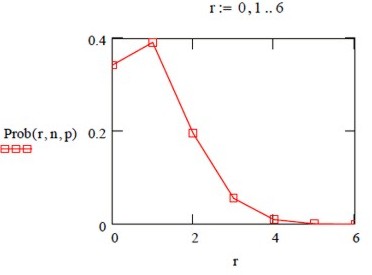
Of course it would take an entire year to write 8 applications. If we take a more realistic case of making four applications we have $ n = 4 $ (and $ p = 0.125 $, as before). In this case the graph comes out as below. You have a nearly 60% chance of getting nothing at all, and only a 1 in 3 chance of getting one grant.
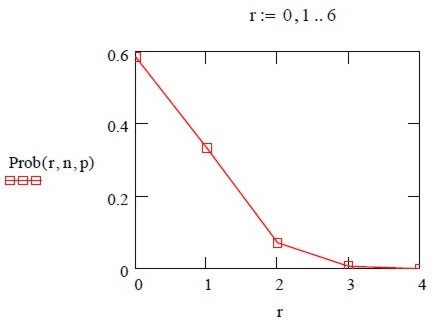
These results arise regardless of merit, purely as consequence of random chance. They are disastrous, and especially disastrous for the smaller, better-value, groups for which a gap in funding can mean loss of vital expertise. It also has the consequence that scientists have to spend most of their time not doing science, but writing grant applications. The mean number of applications before a success is 8, and a third of people will have to write 9 or more applications before they get funding. This makes very little sense.
Grant-awarding panels are faced with the near-impossible task of ranking many similar grants. The peer review system is breaking down, just as it has already broken down for journal publications.
I think these considerations demolish the argument for funding a small number of ‘stars’. The public might expect that the person making the application would take an active part in the research. Too often, now, they spend most of their time writing grant applications. What we need is more responsive-mode smallish programme grants and a maximum on the size of groups.
Conclusions
We should be thinking about the following changes,
- Limit the number of papers that an individual can publish. This would increase quality, it would reduce the impossible load on peer reviewers and it would reduce costs.
- Limit the size of labs so that more small groups are encouraged. This would increase both quality and value for money.
- More (and so smaller) grants are essential for innovation and productivity.
- Move towards self-publishing on the web so the cost of publishing becomes very low rather than the present extortionate costs. It would also mean that negative results could be published easily and that methods could be described in proper detail.
The entire debate is now on YouTube.
Follow-up
24 January 2012. The eminent mathematician, Tim Gowers, has a rather hard-hitting blog on open access and scientific publishing, Elsevier – my part in its downfall. I’m right with him. Although his post lacks the detailed numbers of mine, it shows that mathematicians has exactly the same problems of the rest of us.
11 April 2012. Thanks to Twitter, I came across a remarkably prescient article, in the Guardian, in 2001.
Science world in revolt at power of the journal owners, by James Meek. Elsevier have been getting away with murder for quite a while.
19 April 2012.
|
I got invited to give after-dinner talk on open access at Cumberland Lodge. It was for the retreat of out GEE Department (that is the catchy brand name we’ve had since 2007: I’m in the equally memorable NPP). I think it stands for Genetics, Evolution and Environment. The talk seemed to stiir up a lot of interest: the discussions ran on to the next day. |

|
It was clear that younger people are still as infatuated with Nature and Science as ever. And that, of course is the fault of their elders.
The only way that I can see, is to abandon impact factor as a way of judging people. It should have gone years ago,and good people have never used it. They read the papers. Access to research will never be free until we think oi a way to break the hegemony of Nature, Science and a handful of others. Stephen Curry has made some suggestions
Probably it will take action from above. The Wellcome Trust has made a good start. And so has Harvard. We should follow their lead (see also, Stephen Curry’s take on Harvard)
And don’t forget to sign up for the Elsevier boycott. Over 10,000 academics have already signed. Tim Gowers’ initiative took off remarkably.
24 July 2012. I’m reminded by Nature writer, Richard van Noorden (@Richvn) that Nature itself has written at least twice about the iniquity of judging people by impact factors. In 2005 Not-so-deep impact said
"Only 50 out of the roughly 1,800 citable items published in those two years received more than 100 citations in 2004. The great majority of our papers received fewer than 20 citations."
"None of this would really matter very much, were it not for the unhealthy reliance on impact factors by administrators and researchers’ employers worldwide to assess the scientific quality of nations and institutions, and often even to judge individuals."
And, more recently, in Assessing assessment” (2010).
27 April 2014
The brilliant mathematician,Tim Gowers, started a real revolt against old-fashioned publishers who are desperately trying to maintain extortionate profits in a world that has changed entirely. In his 2012 post, Elsevier: my part in its downfall, he declared that he would no longer publish in, or act as referee for, any journal published by Elsevier. Please follow his lead and sign an undertaking to that effect: 14,614 people have already signed.
Gowers has now gone further. He’s made substantial progress in penetrating the wall of secrecy with which predatory publishers (of which Elsevier is not the only example) seek to prevent anyone knowing about the profitable racket they are operating. Even the confidentiality agreements, which they force universities to sign, are themselves confidential.
In a new post, Tim Gowers has provided more shocking facts about the prices paid by universities. Please look at Elsevier journals — some facts. The jaw-dropping 2011 sum of €1.25 million paid by UCL alone, is now already well out-of-date. It’s now £1,381,380. He gives figures for many other Russell Group universities too. He also publishes some of the obstructive letters that he got in the process of trying to get hold of the numbers. It’s a wonderful aspect of the web that it’s easy to shame those who deserve to be shamed.
I very much hope the matter is taken to the Information Commissioner, and that a precedent is set that it’s totally unacceptable to keep secret what a university pays for services.
